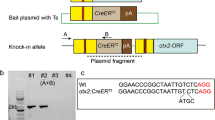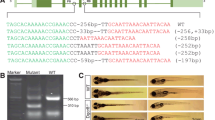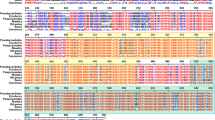Abstract
In zebrafish and other vertebrates, primordial germ cells (PGCs) are a population of embryonic cells that give rise to sperm and eggs in adults. Any type of genetically manipulated lines have to be originated from the germ cells of the manipulated founders, thus it is of great importance to establish an effective technology for highly specific PGC-targeted gene manipulation in vertebrates. In the present study, we used the Cre/loxP recombinase system and Gal4/UAS transcription system for induction and regulation of mRFP (monomer red fluorescent protein) gene expression to achieve highly efficient PGC-targeted gene expression in zebrafish. First, we established two transgenic activator lines, Tg(kop:cre) and Tg(kop:KalTA4), to express the Cre recombinases and the Gal4 activator proteins in PGCs. Second, we generated two transgenic effector lines, Tg(kop:loxP-SV40-loxP-mRFP) and Tg(UAS:mRFP), which intrinsically showed transcriptional silence of mRFP. When Tg(kop:cre) females were crossed with Tg(kop:loxP-SV40-loxP-mRFP) males, the loxP flanked SV40 transcriptional stop sequence was 100 % removed from the germ cells of the transgenic hybrids. This led to massive production of PGC-specific mRFP transgenic line, Tg(kop:loxP-mRFP), from an mRFP silent transgenic line, Tg(kop:loxP-SV40-loxP-mRFP). When Tg(kop:KalTA4) females were crossed with Tg(UAS:mRFP) males, the hybrid embryos showed PGC specifically expressed mRFP from shield stage till 25 days post-fertilization (pf), indicating the high sensitivity, high efficiency, and long-lasting effect of the Gal4/UAS system. Real-time PCR analysis showed that the transcriptional amplification efficiency of the Gal4/UAS system in PGCs can be about 300 times higher than in 1-day-pf embryos. More importantly, when the UAS:mRFP-nos1 construct was directly injected into the Tg(kop:KalTA4) embryos, it was possible to specifically label the PGCs with high sensitivity, efficiency, and persistence. Therefore, we have established two targeted gene expression platforms in zebrafish PGCs, which allows us to further manipulate the PGCs of zebrafish at different levels.






Similar content being viewed by others
References
Abremski K, Hoess R, Sternberg N (1983) Studies on the properties of P1 site-specific recombination: evidence for topologically unlinked products following recombination. Cell 32(4):1301–1311
Asakawa K, Suster ML, Mizusawa K, Nagayoshi S, Kotani T, Urasaki A, Kishimoto Y, Hibi M, Kawakami K (2008) Genetic dissection of neural circuits by Tol2 transposon-mediated Gal4 gene and enhancer trapping in zebrafish. Proc Natl Acad Sci U S A 105(4):1255–1260. doi:10.1073/pnas.0704963105
Blaser H, Eisenbeiss S, Neumann M, Reichman-Fried M, Thisse B, Thisse C, Raz E (2005) Transition from non-motile behaviour to directed migration during early PGC development in zebrafish. J Cell Sci 118(Pt 17):4027–4038. doi:10.1242/jcs.02522
Braat AK, van de Water S, Goos H, Bogerd J, Zivkovic D (2000) Vasa protein expression and localization in the zebrafish. Mech Dev 95(1-2):271–274
Branda CS, Dymecki SM (2004) Talking about a revolution: the impact of site-specific recombinases on genetic analyses in mice. Dev Cell 6(1):7–28
Carey M, Kakidani H, Leatherwood J, Mostashari F, Ptashne M (1989) An amino-terminal fragment of GAL4 binds DNA as a dimer. J Mol Biol 209(3):423–432
Ciruna B, Weidinger G, Knaut H, Thisse B, Thisse C, Raz E, Schier AF (2002) Production of maternal-zygotic mutant zebrafish by germ-line replacement. Proc Natl Acad Sci U S A 99(23):14919–14924. doi:10.1073/pnas.222459999
Davison JM, Akitake CM, Goll MG, Rhee JM, Gosse N, Baier H, Halpern ME, Leach SD, Parsons MJ (2007) Transactivation from Gal4-VP16 transgenic insertions for tissue-specific cell labeling and ablation in zebrafish. Dev Biol 304(2):811–824. doi:10.1016/j.ydbio.2007.01.033
Distel M, Wullimann MF, Koster RW (2009) Optimized Gal4 genetics for permanent gene expression mapping in zebrafish. Proc Natl Acad Sci U S A 106(32):13365–13370. doi:10.1073/pnas.0903060106
Fan L, Moon J, Wong TT, Crodian J, Collodi P (2008) Zebrafish primordial germ cell cultures derived from vasa::RFP transgenic embryos. Stem Cells Dev 17(3):585–597. doi:10.1089/scd.2007.0178
Gallardo T, Shirley L, John GB, Castrillon DH (2007) Generation of a germ cell-specific mouse transgenic Cre line, Vasa-Cre. Genesis 45(6):413–417. doi:10.1002/dvg.20310
Giniger E, Varnum SM, Ptashne M (1985) Specific DNA binding of GAL4, a positive regulatory protein of yeast. Cell 40(4):767–774
Gu H, Marth JD, Orban PC, Mossmann H, Rajewsky K (1994) Deletion of a DNA polymerase beta gene segment in T cells using cell type-specific gene targeting. Science 265(5168):103–106
Guarente L, Yocum RR, Gifford P (1982) A GAL10-CYC1 hybrid yeast promoter identifies the GAL4 regulatory region as an upstream site. Proc Natl Acad Sci U S A 79(23):7410–7414
Hammond SS, Matin A (2009) Tools for the genetic analysis of germ cells. Genesis 47(9):617–627. doi:10.1002/dvg.20539
Hoess RH, Abremski K (1985) Mechanism of strand cleavage and exchange in the Cre-lox site-specific recombination system. J Mol Biol 181(3):351–362
Horton RM, Hunt HD, Ho SN, Pullen JK, Pease LR (1989) Engineering hybrid genes without the use of restriction enzymes: gene splicing by overlap extension. Gene 77(1):61–68
John GB, Gallardo TD, Shirley LJ, Castrillon DH (2008) Foxo3 is a PI3K-dependent molecular switch controlling the initiation of oocyte growth. Dev Biol 321(1):197–204. doi:10.1016/j.ydbio.2008.06.017
Kedde M, Strasser MJ, Boldajipour B, Oude Vrielink JA, Slanchev K, le Sage C, Nagel R, Voorhoeve PM, van Duijse J, Orom UA, Lund AH, Perrakis A, Raz E, Agami R (2007) RNA-binding protein Dnd1 inhibits microRNA access to target mRNA. Cell 131(7):1273–1286. doi:10.1016/j.cell.2007.11.034
Ketting RF (2007) A dead end for microRNAs. Cell 131(7):1226–1227. doi:10.1016/j.cell.2007.12.004
Kimmel CB, Ballard WW, Kimmel SR, Ullmann B, Schilling TF (1995) Stages of embryonic development of the zebrafish. Dev Dyn 203(3):253–310. doi:10.1002/aja.1002030302
Knaut H, Steinbeisser H, Schwarz H, Nusslein-Volhard C (2002) An evolutionary conserved region in the vasa 3'UTR targets RNA translation to the germ cells in the zebrafish. Curr Biol 12(6):454–466
Koprunner M, Thisse C, Thisse B, Raz E (2001) A zebrafish nanos-related gene is essential for the development of primordial germ cells. Genes Dev 15(21):2877–2885. doi:10.1101/gad.212401
Kroehne V, Freudenreich D, Hans S, Kaslin J, Brand M (2011) Regeneration of the adult zebrafish brain from neurogenic radial glia-type progenitors. Development 138(22):4831–4841. doi:10.1242/dev.072587dev.072587
Krovel AV, Olsen LC (2002) Expression of a vas::EGFP transgene in primordial germ cells of the zebrafish. Mech Dev 116(1–2):141–150
Kwan KM, Fujimoto E, Grabher C, Mangum BD, Hardy ME, Campbell DS, Parant JM, Yost HJ, Kanki JP, Chien CB (2007) The Tol2kit: a multisite gateway-based construction kit for Tol2 transposon transgenesis constructs. Dev Dyn 236(11):3088–3099
Lakso M, Sauer B, Mosinger B Jr, Lee EJ, Manning RW, Yu SH, Mulder KL, Westphal H (1992) Targeted oncogene activation by site-specific recombination in transgenic mice. Proc Natl Acad Sci U S A 89(14):6232–6236
Langenau DM, Feng H, Berghmans S, Kanki JP, Kutok JL, Look AT (2005) Cre/lox-regulated transgenic zebrafish model with conditional myc-induced T cell acute lymphoblastic leukemia. Proc Natl Acad Sci U S A 102(17):6068–6073. doi:10.1073/pnas.0408708102
Le X, Langenau DM, Keefe MD, Kutok JL, Neuberg DS, Zon LI (2007) Heat shock-inducible Cre/Lox approaches to induce diverse types of tumors and hyperplasia in transgenic zebrafish. Proc Natl Acad Sci U S A 104(22):9410–9415. doi:10.1073/pnas.0611302104
Liu W, Collodi P (2010) Zebrafish dead end possesses ATPase activity that is required for primordial germ cell development. FASEB J 24(8):2641–2650. doi:10.1096/fj.09-148403
Liu WY, Wang Y, Sun YH, Wang YP, Chen SP, Zhu ZY (2005) Efficient RNA interference in zebrafish embryos using siRNA synthesized with SP6 RNA polymerase. Dev Growth Differ 47(5):323–331. doi:10.1111/j.1440-169X.2005.00807.x
Liu WY, Wang Y, Qin Y, Wang YP, Zhu ZY (2007) Site-directed gene integration in transgenic zebrafish mediated by cre recombinase using a combination of mutant lox sites. Mar Biotechnol (NY) 9(4):420–428. doi:10.1007/s10126-007-9000-x
Liu X, Li Z, Emelyanov A, Parinov S, Gong Z (2008) Generation of oocyte-specifically expressed cre transgenic zebrafish for female germline excision of loxP-flanked transgene. Dev Dyn 237(10):2955–2962. doi:10.1002/dvdy.21701
Livak KJ, Schmittgen TD (2001) Analysis of relative gene expression data using real-time quantitative PCR and the 2(-Delta Delta C(T)) Method. Methods 25(4):402–408. doi:10.1006/meth.2001.1262S1046-2023(01)91262-9
Lomeli H, Ramos-Mejia V, Gertsenstein M, Lobe CG, Nagy A (2000) Targeted insertion of Cre recombinase into the TNAP gene: excision in primordial germ cells. Genesis 26(2):116–117
Luo K, Duan H, Zhao D, Zheng X, Deng W, Chen Y, Stewart CN Jr, McAvoy R, Jiang X, Wu Y, He A, Pei Y, Li Y (2007) 'GM-gene-deletor': fused loxP-FRT recognition sequences dramatically improve the efficiency of FLP or CRE recombinase on transgene excision from pollen and seed of tobacco plants. Plant Biotechnol J 5(2):263–274. doi:10.1111/j.1467-7652.2006.00237.x
Ohinata Y, Payer B, O'Carroll D, Ancelin K, Ono Y, Sano M, Barton SC, Obukhanych T, Nussenzweig M, Tarakhovsky A, Saitou M, Surani MA (2005) Blimp1 is a critical determinant of the germ cell lineage in mice. Nature 436(7048):207–213. doi:10.1038/nature03813
Pan X, Wan H, Chia W, Tong Y, Gong Z (2005) Demonstration of site-directed recombination in transgenic zebrafish using the Cre/loxP system. Transgenic Res 14(2):217–223
Phelps CB, Brand AH (1998) Ectopic gene expression in Drosophila using GAL4 system. Methods 14(4):367–379. doi:10.1006/meth.1998.0592
Saito T, Goto-Kazeto R, Arai K, Yamaha E (2008) Xenogenesis in teleost fish through generation of germ-line chimeras by single primordial germ cell transplantation. Biol Reprod 78(1):159–166. doi:10.1095/biolreprod.107.060038
Scott EK, Mason L, Arrenberg AB, Ziv L, Gosse NJ, Xiao T, Chi NC, Asakawa K, Kawakami K, Baier H (2007) Targeting neural circuitry in zebrafish using GAL4 enhancer trapping. Nat Methods 4(4):323–326. doi:10.1038/nmeth1033
Seok SH, Na YR, Han JH, Kim TH, Jung H, Lee BH, Emelyanov A, Parinov S, Park JH (2010) Cre/loxP-regulated transgenic zebrafish model for neural progenitor-specific oncogenic Kras expression. Cancer Sci 101(1):149–154. doi:10.1111/j.1349-7006.2009.01393.x
Shaikh AC, Sadowski PD (1997) The Cre recombinase cleaves the lox site in trans. J Biol Chem 272(9):5695–5702
Siegal ML, Hartl DL (1996) Transgene coplacement and high efficiency site-specific recombination with the Cre/loxP system in Drosophila. Genetics 144(2):715–726
Slanchev K, Stebler J, de la Cueva-Mendez G, Raz E (2005) Development without germ cells: the role of the germ line in zebrafish sex differentiation. Proc Natl Acad Sci U S A 102(11):4074–4079. doi:10.1073/pnas.0407475102
Suzuki H, Tsuda M, Kiso M, Saga Y (2008) Nanos3 maintains the germ cell lineage in the mouse by suppressing both Bax-dependent and -independent apoptotic pathways. Dev Biol 318(1):133–142. doi:10.1016/j.ydbio.2008.03.020
Thisse B, Heyer V, Lux A, Alunni V, Degrave A, Seiliez I, Kirchner J, Parkhill JP, Thisse C (2004) Spatial and temporal expression of the zebrafish genome by large-scale in situ hybridization screening. Methods Cell Biol 77:505–519
Thummel R, Burket CT, Brewer JL, Sarras MP Jr, Li L, Perry M, McDermott JP, Sauer B, Hyde DR, Godwin AR (2005) Cre-mediated site-specific recombination in zebrafish embryos. Dev Dyn 233(4):1366–1377. doi:10.1002/dvdy.20475
Traven A, Jelicic B, Sopta M (2006) Yeast Gal4: a transcriptional paradigm revisited. EMBO Rep 7(5):496–499. doi:10.1038/sj.embor.7400679
Urasaki A, Morvan G, Kawakami K (2006) Functional dissection of the Tol2 transposable element identified the minimal cis-sequence and a highly repetitive sequence in the subterminal region essential for transposition. Genetics 174(2):639–649. doi:10.1534/genetics.106.060244
Van Doren M, Williamson AL, Lehmann R (1998) Regulation of zygotic gene expression in Drosophila primordial germ cells. Curr Biol 8(4):243–246
Vergunst AC, Jansen LE, Hooykaas PJ (1998) Site-specific integration of Agrobacterium T-DNA in Arabidopsis thaliana mediated by Cre recombinase. Nucleic Acids Res 26(11):2729–2734
Wang L, Zhang Y, Zhou T, Fu YF, Du TT, Jin Y, Chen Y, Ren CG, Peng XL, Deng M, Liu TX (2008) Functional characterization of Lmo2-Cre transgenic zebrafish. Dev Dyn 237(8):2139–2146. doi:10.1002/dvdy.21630
Weidinger G, Stebler J, Slanchev K, Dumstrei K, Wise C, Lovell-Badge R, Thisse C, Thisse B, Raz E (2003) dead end, a novel vertebrate germ plasm component, is required for zebrafish primordial germ cell migration and survival. Curr Biol 13(16):1429–1434
Westerfield M (1995) The zebrafish book: a guide for the laboratory use of zebrafish (Danio rerio). University of Oregon, Eugene
Yoon C, Kawakami K, Hopkins N (1997) Zebrafish vasa homologue RNA is localized to the cleavage planes of 2- and 4-cell-stage embryos and is expressed in the primordial germ cells. Development 124(16):3157–3165
Yoshikawa S, Kawakami K, Zhao XC (2008) G2R Cre reporter transgenic zebrafish. Dev Dyn 237(9):2460–2465. doi:10.1002/dvdy.21673
Youngren KK, Coveney D, Peng X, Bhattacharya C, Schmidt LS, Nickerson ML, Lamb BT, Deng JM, Behringer RR, Capel B, Rubin EM, Nadeau JH, Matin A (2005) The Ter mutation in the dead end gene causes germ cell loss and testicular germ cell tumours. Nature 435(7040):360–364. doi:10.1038/nature03595
Zhan H, Gong Z (2010) Delayed and restricted expression of UAS-regulated GFP gene in early transgenic zebrafish embryos by using the GAL4/UAS system. Mar Biotechnol (NY) 12(1):1–7. doi:10.1007/s10126-009-9217-y
Acknowledgments
The authors thank Prof. Erez Raz for providing the kop-EGFP-F-nos1-3’UTR construct and Prof. Chi-Bin Chien for sharing the pDestTol2pA2 vector. This work was supported by the China 973 Project (2010CB126306 and 2012CB944504) and the National Science Fund for Excellent Young Scholars of NSFC (31222052).
Author information
Authors and Affiliations
Corresponding author
Electronic Supplementary Materials
Below is the link to the electronic supplementary material.
Supplementary Table 1
Primers used in the present study (DOC 71 kb)
Rights and permissions
About this article
Cite this article
Xiong, F., Wei, ZQ., Zhu, ZY. et al. Targeted Expression in Zebrafish Primordial Germ Cells by Cre/loxP and Gal4/UAS Systems. Mar Biotechnol 15, 526–539 (2013). https://doi.org/10.1007/s10126-013-9505-4
Received:
Accepted:
Published:
Issue Date:
DOI: https://doi.org/10.1007/s10126-013-9505-4




